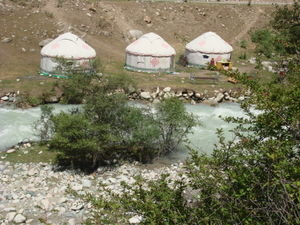Advertisement
Published: July 27th 2008

 Yurts
Yurts
Three yurts.Kyrgyzstan , located in Central Asia, is bordered by Kazakhstan to the north, Uzbekistan to the west, Tajikistan to the southwest and China to the east.
Founded in 1878 as the Russian fortress of Pishpek, between 1926 and 1991 it was known as Frunze after the Bolshevik military leader Mikhail Frunze, who was born in Bishkek, which brings the story around to me. One summer day, roughly two weeks ago, I arrived in Bishkek.
In my quest for culture, one gentle-natured man felt my yearning. Donned in a culpak, traditional hat, he picked up his oz-komuz (mouth harp) and played. His doyng-a-doyng-a-doyng music collided with my smile and when he completed his song, he exchanged his oz-komuz for a chopo choor (clay wind instrument) and began to play. Hadn’t he been looking for an opportunity to share his talent with someone who took culture seriously?
This man could easily have rested on a stool by the glacial Chui River and recited “The Epic of Manas,” a traditional epic poem of the Kyrgyz people, to me. However, I didn’t possess the time or patience to listen to nearly half a million lines, which is twenty times longer than Homer's
Odyssey and Iliad combined.
However, with the passing of a moon or two, I left urban Bishkek behind and traveled 40 minutes by motorized vehicle into the the land of nomads and yurts. The word yurt is originally from the Turkic word meaning "dwelling place." In Russian the structure is called "yurta" (юрта).
As a Westerner, unaccustomed to the nomadic-style of living, I expected well groomed hiking trails, but encountered narrow, animal-forged mountain-side trails. As I crossed plateaus and weaved through briars, the air whispered songs of peace and I snatched morning straight from the air and filled my lungs. At that hour, wasn’t I expecting to live a life of nomadic wisdom?
However surviving on manti (dumplings filled with either onion and meat, or pumpkin), vodka, horsemeat and kumyss, fermented mare's milk put risotto and red wine back into perspective. Kumyss really smacks reality back in place rather quickly.
As I wandered the countryside, with the snow-capped mountain looming above, I eventually arrived at 12 Chimney’s restaurant for a bowl of mushroom soup. In wonder of the magestic scenery, my mind returned to The Gaspar Aitiev (painter from the ‘30s) Art Museum. The exhibits included

 Local's Art Fair
Local's Art Fair
In my quest for culture, one gentle-natured man felt my yearning.antique woven blankets, leather products, such as canteens made from cow and pig udders and paitings from 1930 to the present. The paintings featured nomads weathering mountain blizzards, threshing wheat, or simply riding horseback near their yurts. Nomads would not have possessed the capability to transport large canvases. As I glanced over at the single powerline running up the mountain road, I thought of how just one century can create such a difference in recording data. Several of the museum paintings featured power lines and poles in the foreground of majestic mountain scenes. Today, for the sake of beauty, I would have omitted the lines, but during the ‘30s architectual/industrial development, the local artists were simply recording historical data or expressing pride in advancements.
The afternoon peacefulness was slowly melting into a deadline to return to the Hyatt Regency, Bishkek and then the Manas airport to fly back to Westernization.
Advertisement
Tot: 0.059s; Tpl: 0.011s; cc: 9; qc: 45; dbt: 0.0341s; 1; m:domysql w:travelblog (10.17.0.13); sld: 1;
; mem: 1.1mb

 Yurts
Yurts
 Local's Art Fair
Local's Art Fair










